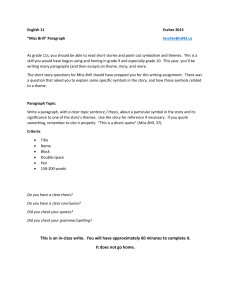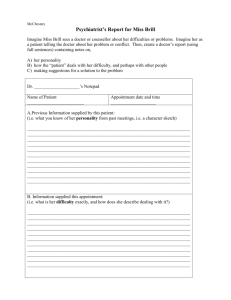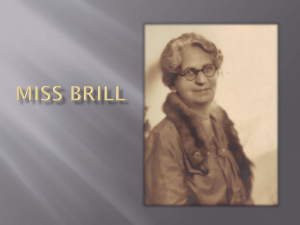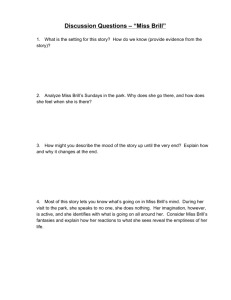Instructions for Authors
advertisement
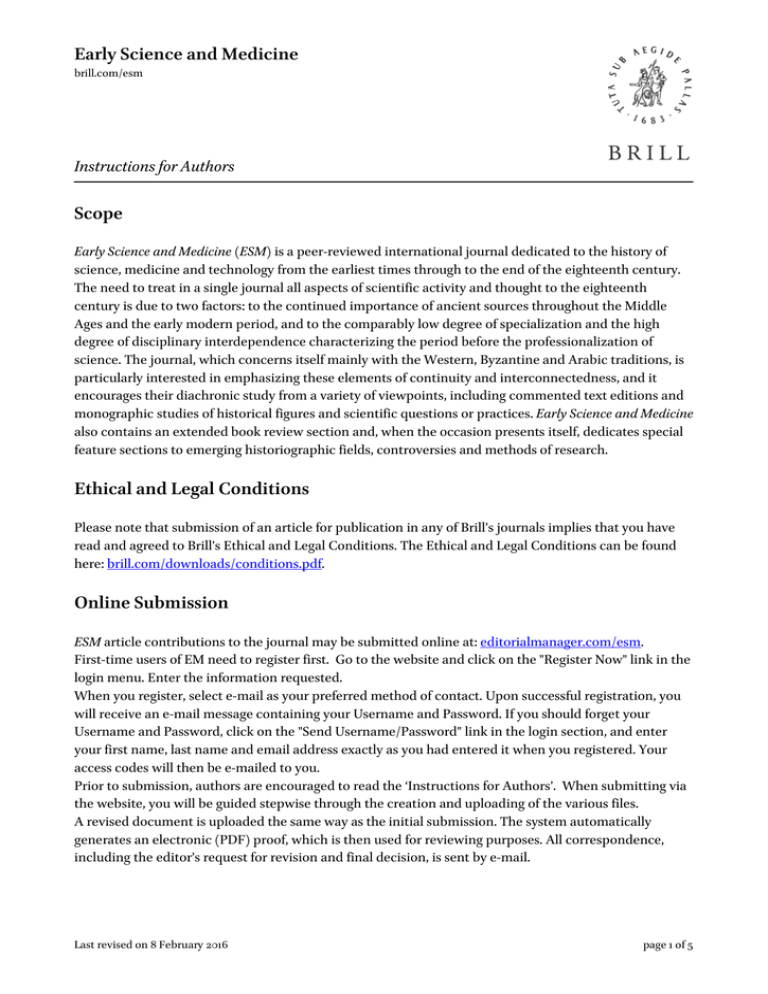
Early Science and Medicine brill.com/esm Instructions for Authors Scope Early Science and Medicine (ESM) is a peer-reviewed international journal dedicated to the history of science, medicine and technology from the earliest times through to the end of the eighteenth century. The need to treat in a single journal all aspects of scientific activity and thought to the eighteenth century is due to two factors: to the continued importance of ancient sources throughout the Middle Ages and the early modern period, and to the comparably low degree of specialization and the high degree of disciplinary interdependence characterizing the period before the professionalization of science. The journal, which concerns itself mainly with the Western, Byzantine and Arabic traditions, is particularly interested in emphasizing these elements of continuity and interconnectedness, and it encourages their diachronic study from a variety of viewpoints, including commented text editions and monographic studies of historical figures and scientific questions or practices. Early Science and Medicine also contains an extended book review section and, when the occasion presents itself, dedicates special feature sections to emerging historiographic fields, controversies and methods of research. Ethical and Legal Conditions Please note that submission of an article for publication in any of Brill’s journals implies that you have read and agreed to Brill’s Ethical and Legal Conditions. The Ethical and Legal Conditions can be found here: brill.com/downloads/conditions.pdf. Online Submission ESM article contributions to the journal may be submitted online at: editorialmanager.com/esm. First-time users of EM need to register first. Go to the website and click on the "Register Now" link in the login menu. Enter the information requested. When you register, select e-mail as your preferred method of contact. Upon successful registration, you will receive an e-mail message containing your Username and Password. If you should forget your Username and Password, click on the "Send Username/Password" link in the login section, and enter your first name, last name and email address exactly as you had entered it when you registered. Your access codes will then be e-mailed to you. Prior to submission, authors are encouraged to read the ‘Instructions for Authors’. When submitting via the website, you will be guided stepwise through the creation and uploading of the various files. A revised document is uploaded the same way as the initial submission. The system automatically generates an electronic (PDF) proof, which is then used for reviewing purposes. All correspondence, including the editor’s request for revision and final decision, is sent by e-mail. Last revised on 8 February 2016 page 1 of 5 Early Science and Medicine brill.com/esm Instructions for Authors File Formats Text files should preferably be in either WordPerfect or Microsoft Word format (and saved as .doc, .wpd, .txt or .rtf). Contact Address For any questions or problems relating to your manuscript please contact the Editors, Christoph Lüthy at: c.luethy@ftr.ru.nl and Michael Edwards at: mje28@cam.ac.uk. For eventual questions about Editorial Manager, authors can also contact the Brill EM Support Department at: em@brill.com. Books for Review Books for review should be sent to the Book Review Editors: Prof. Craig Martin History Department, 416 Varner Hall, Oakland University, Rochester, MI 48309, USA Dr. Valentina Pugliano Christ's College, St Andrew's Street, Cambridge, CB2 3BU, UK Prof. Jole Shackelford Department of the History of Medicine, University of Minnesota, 511 Diehl Hall, 505 Essex St SE, Minneapolis, MN 55455, USA Submission Requirements General The journal is peer-reviewed, which means that all manuscripts will be refereed by the Editors with the help of external experts. Manuscripts that are submitted for initial consideration should therefore be complete, including all notes, bibliographical references, tables, etc. Manuscripts must be clearly typewritten with numbered pages, double-line spacing and wide margins throughout. Do not use desktop publishing features such as justification or centring. Do not hyphenate words at the end of a line. TAB should be restricted to a paragraph indent. Final versions must be proofread carefully before submission and authors may be requested to make changes to their text in accordance with the readers’ comments. Please use your spelling and grammar check; final versions that are not corrected may be returned for renewed proofreading. For general rules on style not touched upon in the style sheet (see below), please refer to the Chicago Manual of Style (16th ed., University of Chicago Press, 2010, online at: chicagomanualofstyle.org/home.html or the most recent edition). Last revised on 8 February 2016 page 2 of 5 Early Science and Medicine brill.com/esm Instructions for Authors The journal reserves the right to copy-edit contributions to conform to its style. Language Articles should be written in English; a limited number of articles may be published each year in French or German at the discretion of the editors. Length The final draft of a manuscript accepted for publication should ideally be 6,000–8,000 words in length. Overly long articles are less likely to be accepted. Font Bold typeface and underline should be avoided. Use italics only where the printed text is to be italicised. Non-Roman Script and Transliteration If a special font is used, please provide a copy of the font. Greek texts should be left in the original and will be printed in Greek characters. If possible, use Kadmos as your font. In all other cases, Greek words should be transliterated into their Greek forms (e.g. Nikonion, not Nicomium). Arabic words and names should be transliterated according to the system adopted by the IJMES. If possible, use TranslitLS font. Other non-Roman alphabets should be transliterated according to the style sheet in the Chicago Manual of Style and should be italicised. Latin and other foreign languages not requiring transcription should be italicised in the typescript. Manuscript Structure Abstracts Articles should include a short abstract of not more than 10 lines, written in English that clearly defines the thesis and the sources quoted. Footnotes Please use footnotes, not endnotes. Footnotes should be brief and limit themselves to what is necessary to document an argument. They should be numbered consecutively throughout the paper. Please place footnote numbers at the end of sentences after punctuation. Notes Notes will be published as footnotes, therefore please include notes as such. Captions (including proper acknowledgements) should be placed at the appropriate position in the article text or sent separately. Last revised on 8 February 2016 page 3 of 5 Early Science and Medicine brill.com/esm Instructions for Authors Headings Headings should be clearly distinguishable, with the first-order heading in bold and a second order heading in bold italics. In case of three-level subdivision, please use numbered sections. All paragraphs are to be indented. Quotations Quotations should be set in double quotes. Long quotations running to several lines should not be enclosed within quotations marks, but should be indented and separated from the preceding and following lines of typescript by a double space. The author’s own translations of foreign-languages passages running to more than a few words should be accompanied by a footnote providing the original text. Bibliographical References Full bibliographical references should be given in the following form: Daniel Garber, “Leibniz on Form and Matter,” Early Science and Medicine, 2 (1997), 326-352. Charles B. Schmitt, “The Rise of the Philosophical Textbook,” in Charles B. Schmitt and Quentin Skinner, eds., The Cambridge History of Renaissance Philosophy (Cambridge, 1988), 792-804. Richard Sorabji, Time, Creation and the Continuum (London, 1983). M. Alexander Stewart, “John Ray,” in Jean-Pierre Schobinger, ed., Ueberweg Grundriss der Geschichte der Philosophie. Die Philosophie des 17. Jahrhunderts, 8 vols. (Basle, 1988-2002), 3/2: 415-424. [= part 3, vol. 2, pp. 415-424]. Aristotle, On the Soul: Parva naturalia: On Breath, trans. W.S. Hett (Cambridge, 1936), 41-43. Pliny, Natural History, trans. H. Rackham et al., 10 vols. (London and Cambridge, MA, 1938-1962). Albertus Magnus, Liber de natura et origine animae II. 7-8, ed. Bernhard Geyer, in Alberti Magni Opera omnia, vol. 12 (Aschendorff, 1955), 29-32. For journal articles, if there is a doi number, please insert it. Short bibliographical references in the footnotes ought to be limited to short titles, of the following form: Sorabji, Time, 18; Stewart, “John Ray,” 419-420. Figures All figures and tables must be cited consecutively in the text. Figures should be submitted as separate source files in .eps, .tif, or .jpg format, in a size suitable for the typesetting area of the journal. The resolution of these files should be at least 300 dpi for half-tone figures, and 600 dpi for line drawings. Number the files, and indicate in the manuscript where they are to appear (Fig. 1 here). The text in a figure must be legible, and should not be smaller than corps 7. The size of this lettering for any text in a figure should be the same for all figures in the manuscript. Last revised on 8 February 2016 page 4 of 5 Early Science and Medicine brill.com/esm Instructions for Authors Illustrations should be submitted electronically and should be clearly marked. When necessary, crops, horizontal or vertical orientation, enlargement of details, etc. should be indicated. Publication Proofs Upon acceptance, a PDF of the article proofs will be sent to authors by e-mail to check carefully for factual and typographic errors. In the event of a multi-authored contribution, proofs are sent to the corresponding author unless otherwise requested. Authors are responsible for checking these proofs and are strongly urged to make use of the Comment & Markup toolbar to note their corrections directly on the proofs. At this stage in the production process only minor corrections are allowed. Alterations to the original manuscript at this stage will result in considerable delay in publication and, therefore, are not accepted unless charged to the author. Proofs should be returned promptly. E-Offprints A PDF file of the article will be supplied free of charge by the publisher to each author. Brill is a RoMEO green publisher. Authors are allowed to post their submitted (pre-peer-review) version of the article at any time. This is the author's own version that had not yet been peer-reviewed, or had any value added to it by Brill (such as formatting or copy editing). Authors may post the accepted (peer-reviewed) version of their article 24 months after publication. This is the version accepted for publication, which contains all revisions made after peer review and copy editing, but has not yet been typeset in the publisher’s lay-out. The publisher’s lay-out must not be used in any repository or on any website. Consent to Publish Transfer of Copyright By submitting a manuscript, the author agrees that the copyright for the article is transferred to the publisher if and when the article is accepted for publication. For that purpose the author needs to sign the Consent to Publish which will be sent with the first proofs of the manuscript. Open Access Should the author wish to publish the article in Open Access he/she can choose the Brill Open option. This allows for non-exclusive Open Access publication under a Creative Commons license in exchange for an Article Publication Charge (APC), upon signing a special Brill Open Consent to Publish Form. More information on Brill Open, Brill’s Open Access Model and the Brill Open Consent to Publish Form can be found on brill.com/brillopen. Last revised on 8 February 2016 page 5 of 5

